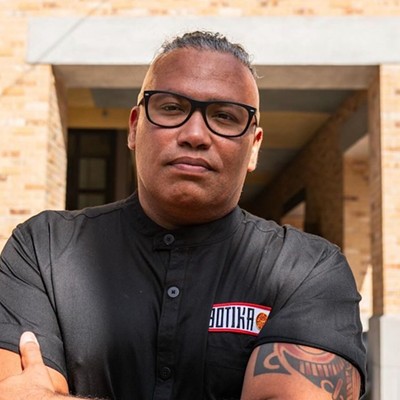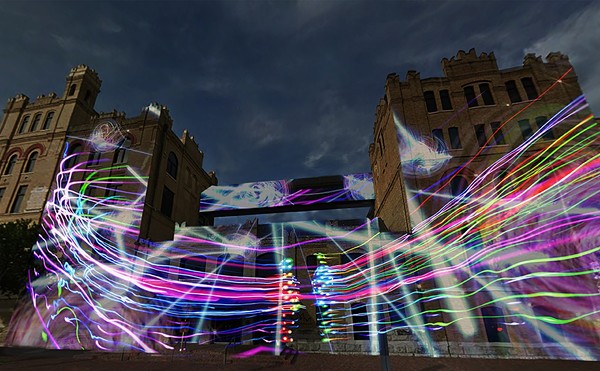|
By Abraham Mahshie On a chilly Easter Sunday, brightly colored eggshells are ground into the gravel and dirt of a driveway on the city's East Side. Family members are gathered for a barbeque and children play in the yard, some with iridescent paint on their faces. People walk quickly in the streets dressed in hooded sweaters, perhaps from the cold, or maybe just to mind their own business. You would think someone who spent nearly seven years in half a dozen Texas prisons would never want to see bars again, but the rusted grates on this family's windows offer a kind of protection from the surrounding neighborhood, where a teenager was dragged from a car and killed only a week before. Years ago, the man of the house, now a professional cook and father, had to find protection inside another set of bars. He had to prove himself. And the tattoos pricked into his skin in dark cells with makeshift needles and homemade ink earned him respect. The images depicted pride for his culture, the street gang with which he identified, his native San Antonio, and a skull and thorns - ambiguous symbols on a man whose reactions you couldn't be sure of. "I was young the first time, a little puppy with the big dogs. They'll fuck with you - and you'll get your ass kicked a lot of times until you learn," explains this hardened 35-year-old, who was locked up the first time on charges of aggressive assault with a deadly weapon. "People do a lot of time and try to prove themselves. All the tattoos I got were free, out of respect." Sheriff's Deputy John A. Gonzalez classifies inmates before they are placed in confinement at the Bexar County Jail, an imposing, block-like structure nestled between dreary pockmarked roads and railroad tracks west of downtown. Part of his job is noting and identifying prisoner's tattoos. "We ask them about problems they have, enemies, past time in prison, race problems. We screen them in other states and we'll look at their tattoos for gang affiliation," he explains. "The main one is the Mexican Mafia; the majority of the members are from San Antonio." Gonzalez pulls out a pocket-sized book, Security Threat Group Tattoos from the Texas Department of Criminal Justice, and flips through the descriptions and photos. "EME," for the Spanish pronunciation of the letter "M," is usually present in a Mexican Mafia tattoo, with two daggers through a sun. In the center, an eagle perches on a cactus with a snake in his mouth, a design taken from the emblem on the Mexican flag. This gang tattoo reflects "Aztlan" cultural imagery often present in the prison tattoos of Mexican Americans. Imagery doesn't come solely from gang or cultural affiliation. Often prisoners have tattoos made identifying their hometowns: "Orejones," symbolized by ears and the words "San Anto," are from San Antonio. "Most back pieces have a gang piece inside if you pay close attention," says a 25-year-old Bexar County inmate called Chino, who used to make tattoos. Though Chino says he is no longer affiliated with a gang, his most prominent tattoo was a gift for a job he did while a gang member: "`Gang leaders` tell you when you do something they can't offer you rank but they can offer you a tattoo to show compensation." Chino's gift was an Asian-style dragon that curls around his right arm from the bicep to his wrist. It was made in three 4- to 5-hour sessions in prison. The dragon's tail at the base of his wrist is in outline because Chino was released before the tattoo could be finished. "This one was done in Hidalgo County, but they can be done anywhere - county jail, halfway house, or prison systems," says Chino.
Ink can be made from any type of darkly colored plastic, such as a chess piece, which is melted down with a lighter, matches, or by a fire lit when a piece of lead is jammed into a wall socket. Styrofoam cups are commonly burned so that their smoke is caught in a plastic bag, leaving a black residue. That residue is then scraped off and mixed with shampoo and water to form the liquid ink. According to Richard, one of the main differences between prison tattoos and professional tattoos is the darkness of the ink. Glycerin- and water-based inks are darker and don't fade over time like prison tattoos. Often when a prison artist "opens up shop" or manufactures a tattoo rig, the recipients will bring their own needles and ink. The artist will also arrange for a fee to be deposited in his or her commissary account - credit for the purchase of cigarettes, toiletries, and additional food. This charge usually ranges from $5-20, depending on the size and detail of the tattoo. Officially, tattooing in prison is prohibited, and the tools are considered contraband and confiscated if found. Penalties can include a hearing for the artist and lock-down for up to 30 days as well as loss of privileges such as phone calls, visitation, and commissary. The recipient of the tattoo won't usually be punished, unless the tattoo is gang-related. "They know how to not get caught," says Gonzalez. "They'll watch, work a little, look outside the door, tell the guys next door to look under the door and alert them if a guard is coming. Then they'll get dressed and act like they're asleep." "If you can draw, you can make tattoos," says Chino, whose brother is a well-known prison tattoo artist. Chino explains that detailed murals are drawn on paper and pressed onto skin that has been rubbed with deodorant. The deodorant absorbs the ink from the paper and retains the image for the tattoo artist to trace. Intricate tattoos can take up to six months to make. According to Richard, prison tattoos take much longer to complete than those done in tattoo parlors because prisoners have only one size needle. "The shading gives it away," notes Richard, who explains that professional tattoo artists use single and multiple needles and varying ink colors to shade, while in prison, one size needle is used with quick, light injections in a circular motion to create gradation. Scarring and infection is a problem for inexperienced tattoo artists using unsanitary needles, which are often sterilized only with a lighter. "I wouldn't trust that," Richard cautions. Yet, he adds, "Some of the tattoos done in prison are beautiful work. You couldn't tell they were done in sessions - they're real nice, clean, proportional." "Go do your interview," encourages the former inmate's 24-year-old wife, as she runs after their toddler. The father reaches for a glass of beer. On top of his wrist you can see the discoloration where a professional tattoo artist removed the ink of the name of a street gang , and elegantly inscribed the name of his daughter in its place. His eyes open wide and stern. He points his finger like a pistol in a quick motion, then raises his head with a smile. "I don't do that anymore," he says, and lifts the glass to his lips. •
|



















